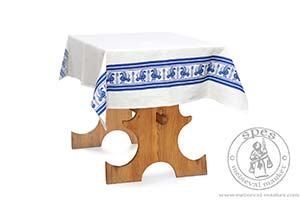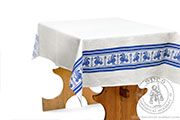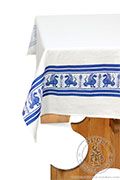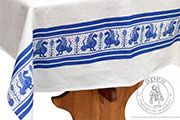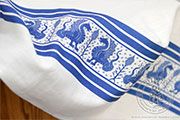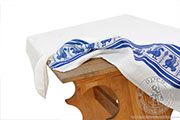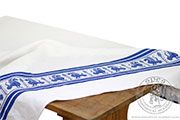If you wish to adjust your cookie preferences for this website, you can do so using your browser settings.
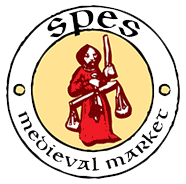


Category: Accessories > kitchen accessories
Tablecloth with medieval theme
Tablecloth with medieval theme
Century: XV| CODE | Material |
Standard
|
Price | |
| NoE1590 | see description | Machine-made | 45.00 EUR |
|
| NoR1591 | see description | Hand-made | 65.00 EUR |
|
Lowest price in the last 30 days
See how to place an order for several people
Tablecloth is a type of textile used to decorate tables, for example during a feast. Who among us does not feel satisfied when spreading a wooden table with a beautiful, clean, white tablecloth? This decoration emphasizes the solemn character of an event.
Our tablecloth is made of white linen and decorated with a medieval theme. More about printing on linen you will find on our blog. This theme is blue and it presents fantastic creatures (similar to dragons) and some unique trees and grapevines. The theme is based on the Florentine fresco, so we can assume it’s typical for 15th century Tuscany.
The tablecloth looks the best with slightly hanging on the sides of a table. The printing should be situated outside the table top. The cloth is perfect for almost any table, but it works the best when it’s slightly bigger than the top. The size of the cloth is 150 x 110 cm. The pattern is on the short sides.
What is the inspiration for our medieval tablecloth?
The blue printing from our medieval tablecloth is based on the fresco by Domenico Ghirlandaio, presenting the Last Supper. You can find it in the refectory of a monastery beside the Ognissanti church, Florence. The work is dated back to 1480. It delights with its details and texture of used materials. The cloth on the picture seems to be smoothly spread over, with decorative sides hanging on sides.Tablecloth in history
The history of tablecloths reaches ancient times. In medieval times, this type of decoration was popular mostly in European courts and churches. At the time, people used block printing technique or weaving to decorate the textile. Later they will be replaced by embroideries or appliques. Tablecloths became more popular among lower social classes in the 19th century, after introducing sewing machines.What do we know about historical "printing" on linen canvases?
The technique of printing canvases, incl. in the 14th-15th centuries was a very popular method of decorating middle class or court outfits.
Medieval Italian artist Cennino Cennini in his book “The Book Of The Art" presented various techniques of applying paint to various types of materials. Among the topics he touched upon were "The way to work on cloth by printing from a shape in colour".
To create a form for printing, you first had to prepare a block of wood, preferably made of walnut or pear, the size of a brick. On the bottom of the block, a pattern had to be drawn and carved, without omitting any details, but in such a way that it was complete from all sides. Copy block should have a handle. Then, using a special glove, the paint (previously prepared, most often black) was taken and spread over the grooved surface. Before putting the form on the canvas, it had to be stretched strongly on a loom. The printing block was applied very tightly and rubbed with it until the ink was settled on the material. You had to be very careful and precise so that the pattern would not be shifted or that there were no gaps between the fragments.
What is more, to make the final effect more interesting, black was combined with some other color. Most often with yellow, red and green. Using a brush, additional colors were filled in animal figures, foliage or fantastic creatures. This way of decorating was perfect for green, red, black, yellow and blue (and even pale blue) canvases. The most important thing was that the colors should contrast with each other, be lighter or darker (e.g. indigo was used on red material, cinnabar on green, etc.).
However, it was important to produce printed linen “(...) which to your fancy it seems you can put together, and one thing will teach you another (...): every art is in its nature ingenious and pleasing: chi ne piglia se n’'ha (he that takes, hath).”.





 Female Clothing
Female Clothing Male clothing
Male clothing
 Furniture
Furniture Tents
Tents Armament
Armament HMB Line
HMB Line Miscellaneous
Miscellaneous Rent
Rent In stock
In stock Special Offers
Special Offers Search
Search Your Account
Your Account About us
About us Sizing
Sizing How to buy
How to buy Blog
Blog Links
Links Events
Events
